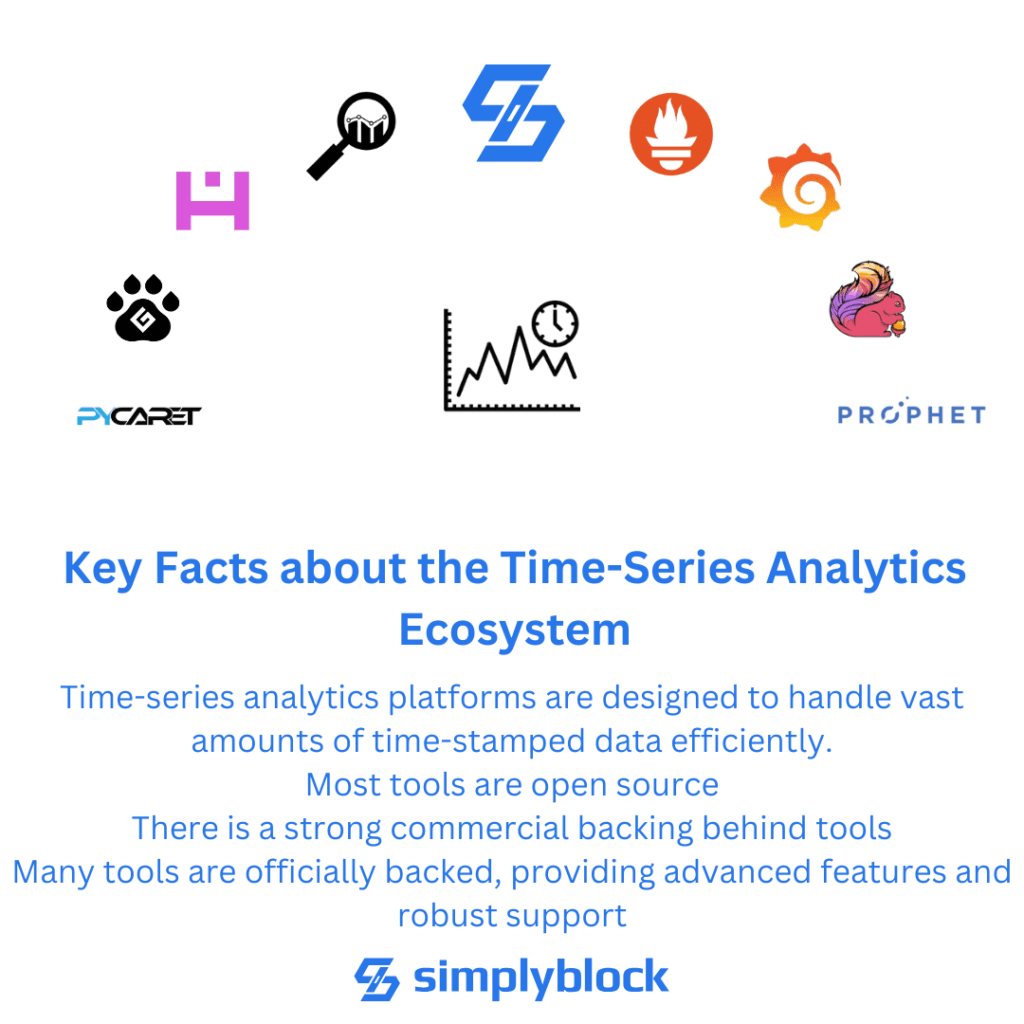The post 9 Best Open Source Tools for Time-Series Analytics and Predictions appeared first on simplyblock.
]]>The world of time-series analytics and predictions is dynamic and continuously evolving. As more organizations gather massive amounts of data, the need for efficient tools to analyze time-series data and make accurate predictions has become paramount. Open-source tools have emerged as essential resources in this domain, offering robust solutions to manage and analyze time-based data efficiently. These tools are crucial for detecting trends, forecasting future values, and automating decision-making processes.
What are the best open-source tools for your time-series analytics setup?
With the growing demand for real-time insights and predictions, the importance of open-source tools in time-series analytics has increased significantly. Developers, data scientists, and analysts are always on the lookout for tools that help them process and predict time-series data with precision. In this post, we will explore nine must-know open-source tools that can help you optimize your time-series analytics and predictions.
1. Prometheus
Prometheus is a powerful open-source system for time-series data collection and storage, widely used for monitoring and alerting. With its ability to efficiently handle high-dimensional data, it allows you to store metrics with timestamps, enabling real-time analysis and predictions. Its integration with visualization tools like Grafana makes it an essential tool for time-series analytics.
2. InfluxDB
InfluxDB is a purpose-built time-series database designed for high-performance handling of time-based data. It excels at ingesting, storing, and analyzing data in real-time, making it perfect for IoT, DevOps monitoring, and application performance metrics. InfluxDB’s query language enables complex analytics, aggregation, and predictions based on time-series data.
3. Grafana
Grafana is an open-source visualization and analytics platform that integrates seamlessly with time-series databases like Prometheus and InfluxDB. It enables users to create rich, interactive dashboards for visualizing time-series data and identifying trends. Its powerful query capabilities make it an excellent tool for monitoring and predictive analytics.
4. Kats (by Facebook)
Kats (Kits to Analyze Time Series) is a lightweight, easy-to-use library developed by Facebook for time-series analysis and predictions. It offers a comprehensive range of features such as forecasting, anomaly detection, and event change detection. Kats simplifies working with time-series data and is highly effective for predictive modeling.
5. Prophet (by Facebook)
Prophet is another tool developed by Facebook, designed for time-series forecasting. It is highly efficient for handling time-series data that contain multiple seasonality with irregular intervals. Prophet’s intuitive interface allows you to quickly generate forecasts with minimal code, making it popular among data scientists for time-series predictions.
6. Druid
Druid is a real-time analytics database designed for fast aggregations and instant data retrieval. It’s ideal for applications that require sub-second query responses on time-series data. Druid offers high scalability and is perfect for analyzing large volumes of time-series data across industries, from digital marketing to IoT.
7. PyCaret
PyCaret is an open-source machine learning library that simplifies time-series forecasting. It automates the process of model selection, training, and evaluation, making it ideal for developers and data scientists who want to quickly build prediction models. PyCaret supports a wide range of algorithms, allowing users to perform robust time-series analysis with ease.
8. OpenTSDB
OpenTSDB is a scalable, distributed time-series database designed for high-throughput data. It enables the collection, storage, and retrieval of billions of data points in real-time, making it suitable for IoT, infrastructure monitoring, and predictive maintenance. OpenTSDB integrates with popular tools like Hadoop for large-scale time-series analysis.
9. Apache Flink
Apache Flink is a stream processing framework that excels at processing time-series data in real-time. With Flink’s stateful streaming, it can handle large-scale, time-based data streams and make predictions on-the-fly. It’s highly versatile, offering advanced features such as windowing, event time, and out-of-order processing, making it ideal for real-time analytics and predictions.

Why Choose simplyblock for Time-Series Analytics?
Time-series databases require specialized storage engines and query optimizations to handle the unique characteristics of temporal data. This is where SimplyBlock’s intelligent orchestration creates unique value:
- Intelligent Time-Series Optimization: Simplyblock implements specialized storage strategies for time-series workloads. The platform optimizes time-based partitioning and data layout while employing efficient compression algorithms specifically designed for timestamp-value pairs. It manages automated downsampling and retention policies, implements smart caching for recent time windows and hot data, and maintains high-speed ingestion buffers with intelligent batch processing to maximize throughput.
- Performance-Optimized Query Engine: Simplyblock manages the complex aspects of time-series query processing by implementing parallel processing of time-range queries and efficient time-based indexing strategies. The platform handles automated aggregation and rollup management, optimizes scan operations for sequential time-based access, and provides smart query routing based on time partitions to ensure optimal performance.
- Enterprise-Grade Time-Series Management: Through Kubernetes integration, simplyblock automates critical operational aspects of time-series management. This includes sophisticated time-based sharding and rebalancing, precise multi-node timestamp synchronization, and efficient high-cardinality series handling. The platform provides comprehensive real-time monitoring of time-series metrics and implements automated backup systems with flexible time-based recovery points for robust data protection.
How to Optimize Time-Series Analytics with Open-source Tools
This guide explored nine essential open-source tools for time-series analytics, from Prometheus’s metrics collection to Apache Flink’s stream processing capabilities. While these tools excel at different aspects – InfluxDB for high-speed ingestion, Prophet for forecasting, and OpenTSDB for scalability – proper implementation is crucial. Tools like Grafana enable visualization, while specialized libraries like Kats and PyCaret simplify predictive modeling. Each tool offers unique capabilities for handling temporal data patterns and time-based queries.
If you’re looking to further streamline your time-series analytics and predictions, simplyblock offers comprehensive solutions that integrate seamlessly with these tools, helping you get the most out of your time-series data processing.
Ready to optimize your time-series analytics? Contact simplyblock today to discover how we can help you enhance your data analysis, performance, and scalability.
The post 9 Best Open Source Tools for Time-Series Analytics and Predictions appeared first on simplyblock.
]]>